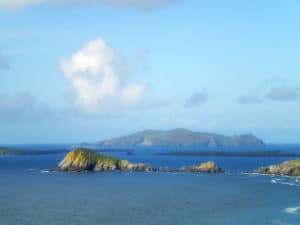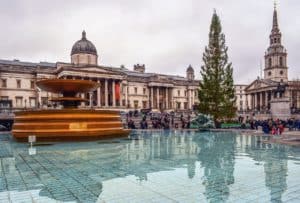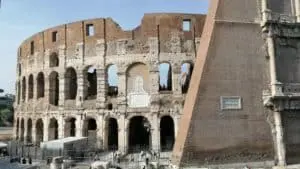Underwater Sculpture Parks: A Confluence of Creativity and Ocean Preservation

Updated On: April 23, 2024 by Maha Yassin
Underwater sculpture parks present a fascinating fusion of human creativity and environmental consciousness. As sea levels rise and coral reefs face unprecedented threats, these submerged galleries offer more than an artistic spectacle; they serve as innovative tools for marine conservation. Spearheaded by visionaries like Jason deCaires Taylor, these installations are strategically designed to support marine life, creating habitats that encourage coral growth and foster biodiversity. By placing sculptures on the ocean floor, artists contribute to the regeneration of marine ecosystems, all while raising awareness about the plight of our oceans.
These artistic endeavours stretch beyond environmental benefits; they also hold significant cultural value and have become tourist attractions in their own right. The visage of sculptures merging with sea life creates a profound statement on the intersection of human and aquatic worlds. They invite onlookers to consider humanity’s impact on the ocean and encourage a dialogue on conservation efforts. Importantly, underwater sculpture parks highlight the symbiotic relationship between art and activism, as they intrigue and educate visitors, potentially leading to a more environmentally-conscious public. The economic implications for regions that house these underwater marvels are palpable, with the burgeoning interest in eco-tourism driving visitors eager for a unique underwater experience.
The Genesis of Underwater Sculpture Parks

The birth of underwater sculpture parks amalgamates creativity with oceanic conservation, epitomised by the pioneering work of Jason deCaires Taylor and his endeavours in Grenada’s Molinere Bay.
Inspiration Behind the Creation
The advent of underwater sculpture parks heralded a revolutionary blend of art and environmentalism. At the heart of this movement was the artist Jason deCaires Taylor, driven by a vision to create aesthetic habitats that promote marine life and foster coral growth. His work serves dual functions: enriching diver experiences and acting as a catalyst for marine conservation.
The Inception of the First Parks
In 2006, Molinere Bay witnessed the inauguration of the world’s first underwater museum, pioneered by Taylor. His seminal project in Grenada carved a niche for submerged artistry and exemplified an innovative approach to marine preservation. Subsequent Molinere Underwater Sculpture Park installations cemented these parks’ dual role in enchanting and safeguarding our underwater frontiers.
The Artistic Approach

In elevating marine conservation efforts, artists and conservationists have turned to an innovative and powerful tool: the underwater sculpture park. These submerged galleries not only serve as tourist attractions but also as a means to foster marine life. Now, let’s explore the creative underpinnings of these aquatic wonders.
Sculptural Techniques
Techniques have been adapted to craft sculptures that withstand the marine environment and promote coral growth. Each sculpture starts as a skilfully moulded form, often using live models to create life-like pieces. Artisans may employ various sculpting techniques, from hand chiselling to contemporary digital methods, ensuring that every detail works in unison with the ocean’s ebb and flow.
The underwater works of Jason deCaires Taylor, a prominent figure in this field, exemplify this approach. By integrating design competition elements and collaborating with marine scientists, Taylor’s creations are not mere statues but habitats shaped to support marine ecosystems.
Materials and Design
Choosing materials for underwater sculptures involves careful consideration of marine safety and structural longevity. Cement is widely used due to its durability and neutrality in water, creating no harm to the ocean’s delicate pH balance. Stainless steel reinforcements often accompany the cement to provide additional strength against the powerful ocean currents.
The design of the sculptures is central to their role as conservation agents. These artworks are meticulously planned to become part of the seafloor, encouraging coral attachment and growth. Porous materials, specific textures, and crevices are incorporated into the designs to attract and house diverse marine species.
In our creation of these submerged marvels, we remain committed to blending aesthetic vision with ecological purpose, ensuring that each underwater gallery not only captivates but also conserves.
Environmental Impact and Marine Life

Underwater sculpture parks serve a dual purpose, marrying the world of art with marine conservation. Not only do they offer a unique underwater cultural experience, but they also contribute positively to marine ecosystems.
Artificial Reefs and Ecosystems
Underwater sculptures often act as artificial reefs, providing new spaces for marine life to colonise and thrive. Made from environmentally friendly materials, these sculptures are designed to withstand the marine environment and gradually integrate with natural reef systems. For instance, the creation of an underwater forest of sculptures in Cyprus has introduced a new habitat for local marine species, which simultaneously assists with tourism management by offering a diversion for divers from natural reef areas. These man-made structures serve as a foundation for coral polyps to attach and grow, contributing to the formation of new coral reefs essential for marine biodiversity.
Marine Biodiversity Flourishment
The strategic placement of underwater sculptures contributes to Marine Biodiversity Flourishment by creating new opportunities for fish and other marine organisms. As these artificial reefs develop, they become home to many marine species, fostering a rich and diversified marine ecosystem. In Grenada’s Underwater Sculpture Park, for example, sculptures made from eco-friendly materials now function as part of the reef environment, supporting the growth and development of local marine life. This bolsters fish populations and enhances overall marine sustainability by alleviating pressures on natural reefs, allowing them time to recover and regenerate.
Conservation Efforts Through Art

In underwater sculpture parks, we see a confluence of creativity and conservation, where art is an innovative tool for marine protection and education. By transforming the seabed into a submerged gallery, these installations do more than captivate the human eye; they promote marine life proliferation and raise critical environmental awareness.
Awareness and Education
We recognise the vital role of awareness and education in marine conservation. Underwater sculptures, both artistic wonders and educational platforms, draw public attention to the plight of our oceans. Installations like those found in the Mediterranean Sea lure marine life and the interest of divers and marine enthusiasts. By witnessing the sculptures evolve into artificial coral reefs, visitors gain a deepened understanding of marine ecosystems and the urgent need for protected areas.
Scientific Research Collaboration
We also see art contributing to scientific research collaboration. Artists collaborate with scientists to inform their designs, blending aesthetics with ecological function. These collaborations foster the creation of sculptures specifically designed to support marine life, turning art installations into valuable habitats. This harmony of art and science is instrumental in establishing new sites for biodiversity and aiding in restoring damaged marine environments, as evident in projects mentioned at the Great Barrier Reef.
By providing structures for coral attachment and growth, these underwater galleries strategically form marine protected areas where fish and invertebrates can thrive. In this way, submerged artworks become part of the marine environment, underscoring the intersection of human creativity and nature conservation.
Cultural Significance and Heritage

Underwater Sculpture Parks serve as a confluence of artistry and conservation, allowing us to preserve our cultural narratives in a transformative way that resonates with the public globally.
Local and Global Influence
We find that underwater sculpture parks capture the essence of cultural pride and heritage in a manner that transcends geographical boundaries. Artists like Jason deCaires Taylor, renowned for his environmental sensibilities and sculptural works such as The Coral Carnival, have successfully harnessed local cultural themes to create installations that appeal to a global audience. An underwater installation preserves the local heritage and catalyses a broader conservation dialogue, engaging a diverse international community.
Cultural Themes and Motifs
The motifs employed in these submerged galleries often reflect poignant cultural themes. They are deliberated over and selected to portray the diverse and rich tapestry of humanity’s shared history. Every sculpture is a cultural heritage repository, from life-sized depictions of community to mythical figures nestled among the coral. Each piece draws visitors into a profound narrative, opening their eyes to the impermanence of human action and the enduring nature of our shared cultural legacy.
By presenting art in an unusual context, these parks also become a powerful statement about the intersection of human creativity and nature’s ingenuity. The interactive aspect of these sculptures with marine life highlights a connection to the natural world, an integral component of our cultural heritage.
Tourism and Economic Implications
Engaging with underwater sculpture parks offers far-reaching implications for tourism attractions and local economies.
Tourism Attraction and Experience
Underwater sculpture parks, such as the Molinère Underwater Sculpture Park, create unique travel experiences, drawing in visitors keen on exploring these immersive art installations. These attractions are not only visually impressive but also serve an educational purpose, highlighting the importance of marine conservation. Such innovative tourism offerings diversify the travel experience and can increase the desirability of a destination.
Benefiting Local Economies
The attraction of visitors to underwater sculpture parks plays a significant role in stimulating local economies. By drawing tourists, these parks support various tourism industry sectors, including accommodation, dining, and retail. The Grenada Tourism Authority, for instance, leverages this unique attraction to boost Grenada’s image as a travel destination, catalysing economic development and providing job opportunities for the local population. Investment in such projects is a strategic approach to economic diversification and resilience in the face of global tourism trends.
Challenges and Controversies

In our pursuit to blend aesthetics with ecology, underwater sculpture parks have emerged as a novel approach to marine conservation. However, they face challenges and controversies, particularly concerning environmental impact and the complexity of regulations.
Environmental Concerns
Marine Life: Our sculptures are designed to promote reef growth, but the impact on local ecosystems needs to be continuously monitored. Altering seabeds and introducing foreign materials can potentially disrupt indigenous species, necessitating a rigorous assessment of ecological effects.
Materials and Durability: Using environmentally inert materials helps reduce negative effects, but over time, even pH-neutral structures can face wear and tear due to climate change and oceanic conditions, possibly leading to unintended consequences on marine life and reef health.
Regulation and Permits
Navigating Laws: Securing permits for underwater installations is a complex process. Each country has its regulations, and areas close to natural reefs might be heavily protected due to conservation efforts, making the legal groundwork for these projects time-intensive and challenging.
Sustainability Commitment: Ensuring our projects align with local and international marine protection statutes requires a clear understanding of environmental law. It’s about balancing creative expression and preserving nature’s delicate balance, requiring us to work closely with regulatory bodies to obtain the necessary permits while upholding conservation principles.
Technology and Innovation in Underwater Sculpture

In underwater sculpture, the marriage of art with marine conservation is achieved through pioneering technology and innovation. We closely examine how this harmony shapes the installation of sculptures and aids in conserving marine ecosystems.
Installation Techniques
Depth plays a critical role in the placement of underwater sculptures. Careful consideration is taken to ensure that the artworks rest at a depth accessible for divers yet stable enough to withstand ocean currents. Local ingenuity and technology are used in the methodologies applied, such as employing GPS guidance for accurate positioning and cranes or flotation devices for lowering sculptures to the seabed.
The materials used for underwater sculptures are selected based on durability and eco-friendliness. Artists favour materials that endure in saltwater environments and encourage marine life to colonise the structures. This includes using pH-neutral marine concrete, which provides a solid base that is safe for aquatic life.
Conservation Technology
In the sector of conservation technology, innovation is key. We utilise a variety of sensors and monitoring equipment to observe the impact of the sculptures on local ecosystems. The growth of coral on sculptures and changes in the behaviour of marine species are meticulously recorded using underwater cameras and data loggers, optimising ICT capabilities for oceanic research.
Technology has also ushered in novel materials engineered to promote coral growth, serving dual purposes: stabilising the sculptures and fostering new habitats for marine organisms. By integrating these advanced materials, we make significant strides in marine conservation, offering alternative reef structures that help to alleviate pressures on natural coral reefs.
Future Directions and Sustainability

In advancing the integration of art and marine conservation, we’re focused on the significance of sustainable practices and the initiation of community-led projects that contribute to the conservation and growth of coral ecosystems.
Sustainable Practices
Underwater sculpture parks provide more than an aesthetic value; they play a vital role in the growth of corals and the broader aspect of marine conservation. The materials used for the sculptures are chosen carefully to ensure they are inert and pH-neutral, promoting coral larvae’s surface attachment and proliferation. The Sunken sculptures help rewild marine ecosystems and serve as an example of the attention given to environmental sustainability in artistic expression.
Regarding planning, future directions include using advanced materials with longer lifespans and minimal ecological footprints. Our parks are planning upgrades that include resilient structures able to withstand the challenges posed by climate change, considering the preservation of marine life and the interaction and impact on the seabed.
Community and Future Initiatives
We recognise the importance of involving local communities in the conservation efforts. By engaging local stakeholders, we ensure that the parks are not only a tourist attraction but also an educational and economic asset for local populations. Our planned communities and future initiatives revolve around educational programmes that inform locals and visitors about marine ecosystems and their preservation.
Furthermore, we’re working on upgrade initiatives that align with sustainable tourism practices. This includes the development of virtual tours to minimise the environmental impact of human traffic and preserve the integrity of the underwater sites. Our collaboration efforts extend to scientists and coral farmers, fostering a rich exchange of knowledge essential for the continued conservation of these underwater marvels and securing our shared oceans’ sustainability for future generations.
Art and Activism in Marine Conservation
Underwater sculpture parks serve as a nexus where the powerful world of visual art meets marine conservation efforts. These installations do more than beautify the underwater landscape; they foster environmental awareness and inspire action.
Artists as Activists
Artists harness their creativity to become influential activists within marine sustainability. By sculpting figures and forms immersed in the ocean, they create arresting scenes that capture the global community’s attention. One notable example is the underwater forest of sculptures in Cyprus, designed not only to attract marine life but to send a strong message about environmental preservation in a way that words alone cannot.
Sculptures with a Message
Every submerged figure carries a message, a call to action against the threats facing our oceans. These sculptures act as artificial reefs, creating habitats for marine life while highlighting urgent issues like climate change. The Museum of Underwater Art in Australia, for instance, not only draws divers for its aesthetic appeal but also utilises art to communicate the dire need for ocean conservation.
Engagement and Interaction

Underwater sculpture parks offer a unique blend of art and marine conservation, providing an immersive experience for the public and promoting global awareness through social media channels. Active participation and widespread digital reach foster greater interplay between creativity and sustainability.
Public Involvement
We recognise the significance of public involvement in the success of underwater sculpture parks. Engagement is heightened by inviting visitors to witness the thriving ecosystems amidst sculptures, such as those forming the ‘coral carnival’. This tangible interaction educates individuals about marine conservation and leaves a lasting impression of the necessity for preserving our underwater habitats.
Social Media and Global Reach
In today’s interconnected world, social media attention plays a vital role in amplifying the message of underwater sculpture parks. Platforms like Instagram and Facebook serve as powerful tools, propelling images and stories of the parks to a global audience. This digital exposure illuminates the beauty and importance of these aquatic galleries and underscores the critical interplay between environmental awareness and artistic expression.

FAQs
Exploring underwater sculpture parks reveals the confluence of creativity and conservation. These marvels enrich the marine environment and serve as a canvas to express poignant environmental narratives.
What benefits do underwater sculptures provide to marine ecosystems?
Underwater sculptures act as artificial reefs, offering a resilient structure for marine life to colonise and thrive. They aid in diverting tourist traffic away from natural reefs, reducing direct human impact.
Could you explain the symbolism behind Jason deCaires Taylor’s subaquatic artworks?
Each of Taylor’s sculptures is nuanced with themes addressing human interactions with nature, the fragility of ecosystems, and the impermanence of our existence, serving as a silent advocate for protecting our oceans.
Which artist is renowned for creating sculptures below the water’s surface?
British sculptor Jason deCaires Taylor is renowned for pioneering underwater installations, blending art with marine conservation.
In what ways does Jason deCaires Taylor contribute to environmental conservation through his artwork?
Through his sculptures, Jason deCaires Taylor offers a habitat for marine life, fosters coral growth and raises awareness about marine preservation by marrying visual storytelling with ecological science.
How are underwater sculpture parks contributing to coral reef restoration?
Underwater sculpture parks serve as platforms for coral polyps to attach and grow, creating new reef frameworks that are more resistant to threats like bleaching, exacerbated by climate change.
What materials are used to ensure underwater sculptures’ longevity and ecological compatibility?
The sculptures are crafted from pH-neutral marine-grade materials designed to be durable and environmentally friendly to ensure the attraction of marine life and the development of bio-diverse reef systems.






